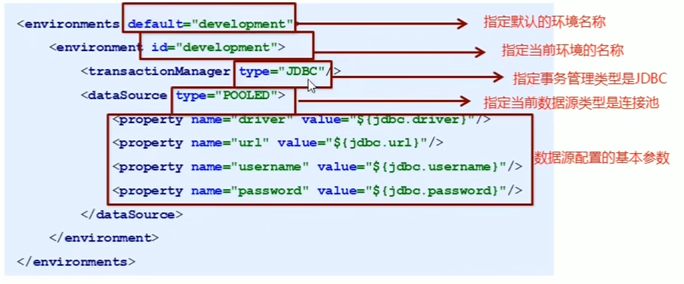MyBatis简介
- 使用数据库连接池初始化连接资源
- 将sql语句抽取到xml配置文件中
- 使用反射、内省等底层技术,自动将实体与表进行属性与字段的自动映射
开发步骤:
- 添加mybatis坐标
- 创建数据表
- 编写实体类
- 编写映射文件xxxMapper.xml
- 编写核心文件SqlMapConfig.xml
- 编写测试类
MyBatis增删改查操作
插入操作
- 插入语句使用insert标签
- 在映射文件中使用parameterType属性指定要插入的数据类型
- Sql语句中使用#{实体属性名}方式引用实体中的属性值
- 插入操作使用的API是sqlSession.insert(“命名空间.id”,实体对象);
- 插入操作涉及数据库数据变化。所以要使用sqlSession对象显示的提交事务,即sqlSession.commit()
修改操作
- 修改语句使用update标签
- 修改操作使用的API是sqlSession.update(“命名空间.id”,实体对象);
删除操作
- 删除语句使用delete标签
- 删除操作使用的API是sqlSession.delete(“命名空间.id”,Integer);
MyBatis核心配置文件解析
environments标签
可以包括多个环境
mapper标签
该标签作用是加载映射
- 使用相对于类路径的资源引用,例如:
<mapper resource="org/mybatis/builder/AuthorMapper.xml"/> - 使用完全限定资源定位符(URL),例如:
<mapper url="file:///var/mappers/AuthorMapper.xml"/> - 使用映射器接口实现类的完全限定类名,例如:
<mapper class="org.mybatis.builderAuthorMapper'/> - 将包内的映射器接口实现全部主册为映射器,例如:
<package name="org.mybatis.builder" />
properties标签
加载额外配置的properties文件
typeAliases标签
类型别名为java类型设置一个别名,基本数据类型不需要
<typeAliases>
<typeAlias type="top.handsomelv.domain.User" alias="user"/>
</typeAliases>MyBatis代理开发方式
采用Mybatis的代理开发方式实现DAO层的开发
Mapper接口开发方法只需要程序员编写Mapper接口(相当于Dao接口),由Mybatis框架根据接口定义创建接口的动态代理对象,代理对象的方法体同上边Dao接口实现类方法。
Mapper接口开发需要遵循以下规范:
- Mapper.xml文件中的namespace与mapper接口的全限定名相同
- Mapper接口方法名和Mapper.xml中定义的每个statement的id相同
- Mapper接口方法的输入参数类型和mapper.xml中定义的每个sql的parameterType的类型相同
- Mapper接口方法的输出参数类型和mapper.xml中定义的每个sql的resultType的类型相同
getMapper(mapper.class);动态SQL语句
<if
条件判断
<select id="findByCondition" resultType="user" parameterType="user">
select * from user
<where>
<if test="id!=0">
id=#{id}
</if>
<if test="username!=null">
and username=#{username}
</if>
<if test="password!=null">
and password=#{password}
</if>
</where>
</select>
<foreach
循环执行sql的拼接操作,例如select * from user where id in (1,2,5)
<select id="findByIds" parameterType="list" resultType="user">
select *
from user
<where>
<foreach collection="list" open="id in (" close=")" item="id" separator=",">
#{id}
</foreach>
</where>
</select>SQL片段抽取
将重复的sql提取出来,使用时用include引用
<sql id="select">select * from user</sql>
<include refid="select"></include>核心配置文件深入
typeHandlers标签
类型处理器将获取的值以合适的方式转换成java类型。
自定义类型处理器处理不支持的非标准类型;实现org.apache.ibatis.type.TypeHandler接口,或继承一个很便利的类org.apache.ibatis.type.BaseTypeHandler,然后可以选择性地将它映射到一个JDBC类型。
- 定义转换类继承类BaseTypeHandler
- 覆盖4个未实现的方法,其中setNonNullarameter为java程序设置数据到数据库的回调方法,getNullableResult为查询时 mysql的字符串类型转换成java的Type类型的方法
- 在MyBatis核心配置文件中进行注册
plugins标签
Mybatis使用第三方插件进行功能拓展,分页助手PageHelper将分页的复杂操作进行封装,使用简单的方式获得分页的相关数据
- 导入通用PageHelper坐标
- 核心配置文件配置插件
- 测试分页数据获取
MyBatis多表操作
一对一查询
案例:查询一个订单同时查询出订单所属的用户
因此Order包含User类
association定义多对一关系
- 创建数据库模型
- 撰写一对一查询的语句
- 创建实体
- 创建接口
- 配置映射文件xml
<resultMap id="orderMap" type="order">
<!--手动指定字段与实体属性的映射关系
column: 数据表的字段名称
property:实体的属性名称
-->
<id column="oid" property="id"></id>
<result column="ordertime" property="ordertime"></result>
<result column="total" property="total"></result>
<!--<result column="uid" property="user.id"></result>
<result column="username" property="user.username"></result>
<result column="password" property="user.password"></result>
<result column="birthday" property="user.birthday"></result>-->
<!--
property: 当前实体(order)中的属性名称(private User user)
javaType: 当前实体(order)中的属性的类型(User)
-->
<association property="user" javaType="user">
<id column="uid" property="id"></id>
<result column="username" property="username"></result>
<result column="password" property="password"></result>
<result column="birthday" property="birthday"></result>
</association>
</resultMap>
<select id="findAll" resultMap="orderMap">
SELECT *, o.id oid
FROM orders o,
USER u
WHERE o.uid = u.id
</select>一对多查询
案例:一个用户的所有订单
collection对应一对多关系
多对多查询
与一对多查询类似
Mybatis注解开发
常用注解
@Insert|Delete|Update|Select:实现增删改查@Result|Results:实现结果集或多个结果集封装@One:实现一对一结果集封装@Many:实现一对多结果集封装
<!--加载映射关系-->
<mappers>
<!--指定接口所在的包-->
<package name="com.itheima.mapper"></package>
</mappers>
@Result:
- 代替了
<id>标签和<result>标签column:数据库列名,property:需要装配的属性名one:需要使用的@One注解(@Result(one=@One)()))many:需要使用的@many注解(@Result(many=@many)()))
@One:代替了
<assocation>标签,在注解中用来指定子查询返回单一对象
select:指定用来多表查询的sqlmapper使用格式:
@Result(property= "" ,column="" ,@One(select=""))
@Many:代替了
<collection>标签,在注解中用来指定子查询返回对象集合使用格式:
@Result(property= "" ,column="" ,@Many(select=""))

可以留下你的信息哦(去Github_issues)😀😀😀
GitHub Issues